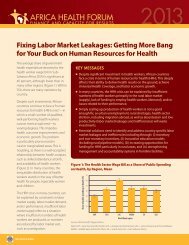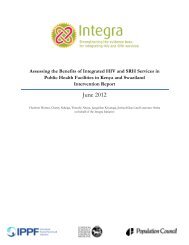ujh78
ujh78
ujh78
You also want an ePaper? Increase the reach of your titles
YUMPU automatically turns print PDFs into web optimized ePapers that Google loves.
Diarrhea. Overall, we did not find sex disparities related to rates of child diarrhea. In half of<br />
these countries, the diarrhea prevalence for children less than age 5 was lower in urban areas than in rural<br />
areas. In 13 of 23 countries, the prevalence of diarrhea was higher for children living with a female<br />
household head than for children living with a male household head. In Burundi, Kenya, and Uganda, the<br />
age of the household head played an important role in diarrhea prevalence among children less than age 5.<br />
In six countries—Cameroon, Ghana, Kenya, Namibia, Tanzania, and Zimbabwe—the prevalence of<br />
diarrhea among children less than age 5 increased between surveys in the last 13 years. This increase was<br />
more than four percentage points in Cameroon and Ghana.<br />
Medical treatment of diarrhea. In 17 of 23 African countries, the percentage of children who<br />
did not receive medical advice for recent diarrhea was higher for girls than for boys. In two-thirds of the<br />
sub-Saharan African countries recent diarrhea was less likely to receive medical attention in rural areas<br />
than in urban areas. These disparities were greatest—at least 15 percentage points—in Ethiopia, Guinea,<br />
Madagascar, Mali, and Niger. In two-thirds of these sub-Saharan African countries, the percentage of<br />
children who did not receive medical advice for diarrhea was higher for children living with a male<br />
household head than for those living with a female household head. This difference was greatest—more<br />
than six percentage points–in Mozambique, Guinea, Cameroon, and Nigeria. In half of these countries,<br />
the percentage of children who did not receive medical advice was higher for children living with a<br />
household head younger than 50 years old than for children living with an older household head. The<br />
percentage of children who had diarrhea in the two weeks prior to the survey and did not receive medical<br />
advice decreased between surveys in every sub-Saharan African country except Benin (increase of 3.8<br />
percentage points).<br />
7.3 Water and Sanitation Deprivation<br />
Use of surface water. Overall, we did not find sex disparities related to the use of surface water<br />
in sub-Saharan Africa. However, we did find geographic disparities. In these countries a higher<br />
percentage of children in rural areas used surface water than in urban areas. The percentage of children<br />
using surface water was at least five percentage points higher for children living with a male household<br />
head than for children living with a female household head in Benin, Ethiopia, Ghana, Guinea, Liberia,<br />
and Madagascar. Additionally, the percentage of children using surface water was at least three<br />
percentage points higher for children living with a household head at least 50 years old than for children<br />
living with a younger head of household head in Cameroon, Kenya, Namibia, and Nigeria. Ethiopia, with<br />
an increment of 29 percentage points, experienced the greatest increase in the percentage of children who<br />
used surface water. Other countries that experienced relatively significant increases included Rwanda (11<br />
percentage points) and Zimbabwe (8 percentage points). In contrast, Madagascar experienced the greatest<br />
decrease on the continent (11 percentage points). An additional five countries (Burkina Faso, Ghana,<br />
Kenya, Madagascar, and Malawi) also experienced a decrease of more than five percentage points in the<br />
percentage of children using surface water.<br />
15 minute walk to the water source. There were no sex disparities related to the percentages of<br />
children who had to walk 15 minutes or more to their water source. In every country except Liberia, this<br />
percentage was higher in rural areas than in urban areas. Whether the percentage of children living more<br />
than a 15 minute walk from the primary water source was higher for children living with a male or a<br />
female household head varied across these countries. The age of the household head was especially<br />
important in Namibia, where the percentage of children living more than a 15 minute walk from the<br />
primary water source was 16 percentage points higher for children living with a household head at least<br />
50 years of age than for those who lived with a younger household head. Over the last 13 years large<br />
increases in the percentage of children living more than a 15 minute walk from a primary water source<br />
occurred in Benin, Cameroon, Ethiopia, and Rwanda. This increase was most evident in Ethiopia, at 10<br />
138








